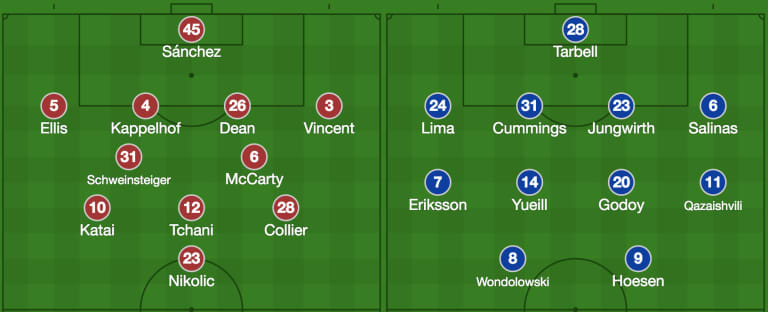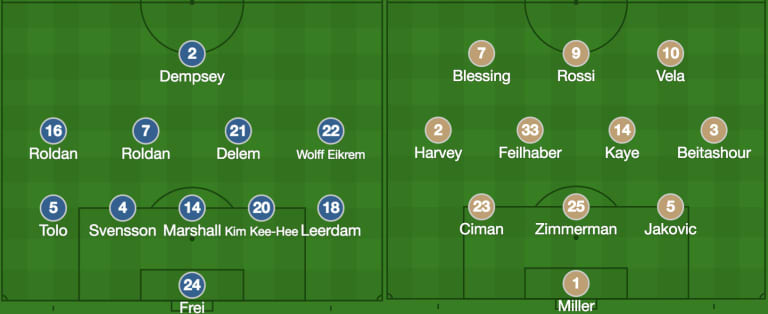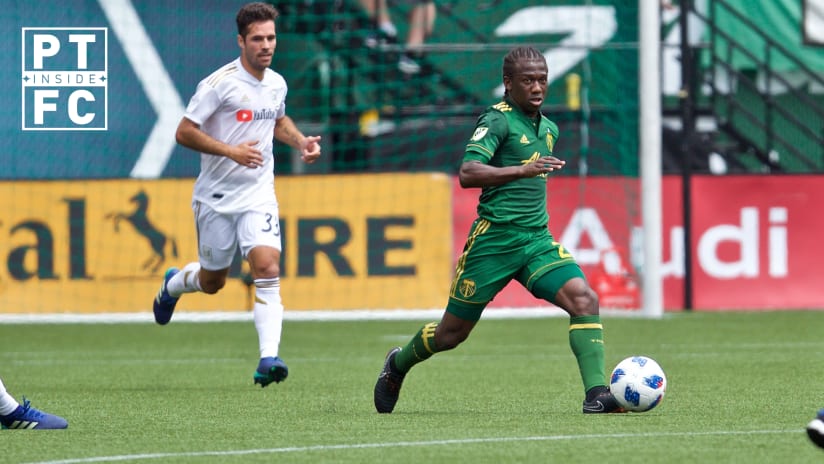PORTLAND, Ore. – It’s a pattern that began in Chicago, just after a Diego Valeri counterattack goal had put the Fire down, and 96 minutes after the Portland Timbers had adopted their new, 4-3-2-1 formation the week before. Bastian Schweinsteiger, originally deployed as the Chicago’s deepest midfielder, took a step back in the formation, setting up between Vlejko Paunovic’s starting center backs, and making the Fire’s pair into a three-man group.
Schweinsteiger would still roam, alternating between deep-lying orchestrator and midfield opportunist. It bit the Timbers in the end, when the German legend popped up on the right flank to find Brandon Vincent with a far-post cross, but the impact on Portland’s season went beyond that late, equalizing goal. In finding a solution for the Timbers’ counter, Chicago showed others how to contain Portland’s main source of production.
It took four games, though, before other teams caught on, and over that time, Portland scored nine goals, with none of Orlando City SC, Minnesota United FC, New York City FC nor the San Jose Earthquakes reproducing the Fire’s approach. Over the last two games, however, the Timbers have finally seen a change. The weekend before last, Seattle Sounders FC stayed with the 5-4-1 formation, while Saturday’s game at Providence Park saw Los Angeles FC return to the 5-back setup they’ve used on occasion this season.

(left: Chicago's starting XI vs. Timbers, March 31, 2018. Fire switched to a 3-4-1-2 in the first half; right: San Jose's starting XI vs. Timbers, May 5, 2018.)
Perhaps predictably, the scoring has slowed, with the Timbers down to 1.5 goals per 90 minutes over that the last two games. But those changes have also allowed Portland control each games’ tempo, stay secure in their attacking shape, and limit the goals they’ve given up. Whereas the preceding four matches saw the Timbers concede five times, the last 180 minutes have left opponents with only one goal.
Span |
Goals |
Shots |
Shots on target |
Goals allowed |
Shots allowed |
SoT allowed |
|---|---|---|---|---|---|---|
Games 5 through 8 |
2.25 |
12.75 |
5.00 |
1.25 |
16.50 |
4.75 |
Games 9 and 10 |
1.50 |
15.50 |
4.50 |
0.50 |
7.50 |
3.00 |
The tradeoff, here, comes down to avoiding man-down scenarios at the back. As the Timbers responded to their season-opening losses against the LA Galaxy and New York Red Bulls, the counterattack of
Fanendo Adi
,
Sebastián Blanco
and Valeri emerged as the team’s most dangerous weapon. Soon, it became worth testing whether that counter was Portland’s only weapon. Hence adding a player to central defense, liberating the fullbacks to create the width, and, in attack, setting up a shell to play around Portland’s 4-3-2-1 formation.

(left: Seattle Sounders starting XI vs. Timbers, May 15, 2018; right: LAFC starting XI vs. Timbers, May 21, 2018)
But you can’t just add a player to central defense without compensating elsewhere on the field. When Chicago did so, they switched from a 4-3-3 formation to a 3-4-1-2, essentially sacrificing the attacking strength their two-highest midfielders would add to their attacking three. Seattle also took their tradeoff in attack, albeit while leaving two in central midfield, while Los Angeles FC picked a different approach. Usually choosing a three-man midfield, Bob Bradley dropped 20-year-old Colombian Eduard Atuesta, putting veteran center back Dejan Jakovic at right-center back in his 5-2-3/3-4-3 setup.
In doing so, both Seattle and LAFC put their teams’ midfields at a disadvantage, explaining why those games gave Portland a level of control we hadn’t seen in the first eight games of the season. Given the choice of those two scenarios, many coaches would be fine moving their problems farther away from goal, but a look at how Portland’s midfielders have performed against two-man middles shows the problem is still one that has to be solved.
In terms of successful passes into opponents’ final thirds, the midfield of Diego Chara, Cristhian Paredes and Andy Polo have put up their best numbers in those three-on-two situations, with advantages against San Jose, Seattle, and LAFC resulting in the trio’s best numbers of the season:
<strong>Rank</strong> |
<strong>Opponent</strong> |
<strong>Successful passes</strong> |
1 |
vs. Seattle Sounders* |
20 |
2 |
at San Jose Earthquakes* |
18 |
3 |
vs. Los Angeles FC* |
17 |
4 |
vs. Minnesota United |
13 |
5 |
at Orlando City SC |
12 |
Chara, Paredes and Polo have only started these five games together, so it’s possible, once we have some more matches to look at, these numbers won’t feel remarkable. But in thinking about Portland’s three-versus-two edge and seeing, during these games, how each midfielder has freedom of seek out play in the middle, you understand the possible causation, and you see why the trend could continue. If teams have to sacrifice a midfielder to offset the Timbers’ main scoring threat, Chara, Paredes and Polo are bound to prosper.
The other factor here is forcing teams away from what they do best. Chicago isn’t a 3-4-1-2 team. Seattle won’t play out 2018 in a 5-4-1, and LAFC’s preferred shape usually puts three in midfield. None of those teams are going to choose three central defenders all the time, but before facing Portland, they decided it was better to change their approach. If you’re Giovanni Savarese, you may be fine with teams breaking from their preferred setup. You want them to go away from what they do most.
You have to think that, at some point, teams will start taking their chances with Portland’s counter, again. The trend that began in Chicago will have to change course. Whether that’s through forgetting how potent it can be, a willingness to engage in a shootout (if need be), or coming up with new solution, there’s going to be a new approach to containing Savarese’s squad. Because as much as Portland once looked to be reliant on its counter, now, their midfield’s capable of punishing any team’s unbalanced approach.












